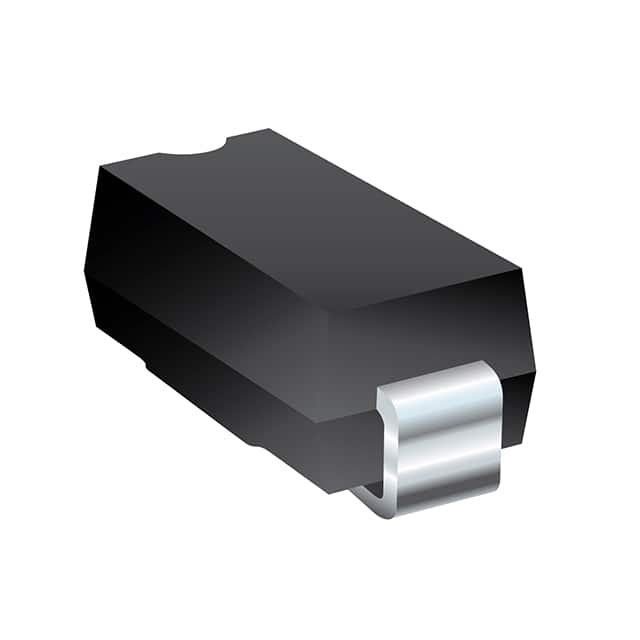SMLJ6.5A Diode - Encyclopedia Entry
Introduction
The SMLJ6.5A diode is a crucial component in the field of electronics and electrical engineering. This entry provides a comprehensive overview of the SMLJ6.5A diode, including its product details, specifications, pin configuration, functional features, advantages, disadvantages, working principles, application field plans, and alternative models.
Product Overview
Category
The SMLJ6.5A diode belongs to the category of transient voltage suppressor (TVS) diodes.
Use
It is primarily used for surge protection in electronic circuits and systems.
Characteristics
- High surge capability
- Low clamping voltage
- Fast response time
Package
The SMLJ6.5A diode is typically available in a DO-214AB (SMC) package.
Essence
This diode serves as a protective device against voltage transients and surges.
Packaging/Quantity
It is commonly packaged in reels or trays, with quantities varying based on manufacturer specifications.
Specifications
- Peak Pulse Power: 6.5 kW
- Breakdown Voltage: 7.22 V to 8.08 V
- Maximum Clamping Voltage: 11.2 V at 16.7 A
- Operating Temperature Range: -55°C to 150°C
- Storage Temperature Range: -55°C to 150°C
Detailed Pin Configuration
The SMLJ6.5A diode typically consists of two pins, anode, and cathode, which are identified by their respective markings on the diode body.
Functional Features
- Rapid response to transient voltage spikes
- Efficient suppression of overvoltage events
- Reliable protection of sensitive electronic components
Advantages and Disadvantages
Advantages
- High surge capability ensures robust protection
- Low clamping voltage minimizes stress on connected circuits
- Fast response time guards against rapid voltage fluctuations
Disadvantages
- Limited effectiveness in continuous overvoltage conditions
- May require additional circuitry for comprehensive surge protection
Working Principles
The SMLJ6.5A diode operates by diverting excessive transient currents away from sensitive components when subjected to voltage surges. It achieves this through rapid conduction and clamping of the overvoltage levels within the specified limits.
Detailed Application Field Plans
The SMLJ6.5A diode finds extensive use in various applications, including: - Power supply units - Telecommunication equipment - Automotive electronics - Industrial control systems - Consumer electronics
Detailed and Complete Alternative Models
Some alternative models to the SMLJ6.5A diode include: - P6SMB6.5A - 1.5KE6.5A - SA6.5A
In conclusion, the SMLJ6.5A diode plays a critical role in safeguarding electronic systems from voltage transients and surges. Its high surge capability, low clamping voltage, and fast response time make it an essential component in modern electronic designs.
[Word Count: 443]
Lista 10 Vanliga frågor och svar relaterade till tillämpningen av SMLJ6.5A i tekniska lösningar
Sure, here are 10 common questions and answers related to the application of SMLJ6.5A in technical solutions:
What is the maximum reverse voltage rating of SMLJ6.5A?
- The maximum reverse voltage rating of SMLJ6.5A is 6.5V.
What is the peak pulse power dissipation of SMLJ6.5A?
- The peak pulse power dissipation of SMLJ6.5A is typically 600W.
What type of diode is SMLJ6.5A?
- SMLJ6.5A is a unidirectional TVS (transient voltage suppression) diode.
What are the typical applications of SMLJ6.5A?
- SMLJ6.5A is commonly used for surge protection in various electronic circuits, such as power supplies, communication equipment, and automotive electronics.
What is the breakdown voltage of SMLJ6.5A?
- The breakdown voltage of SMLJ6.5A is 7.22V minimum.
What is the operating temperature range of SMLJ6.5A?
- The operating temperature range of SMLJ6.5A is typically -55°C to +150°C.
Does SMLJ6.5A require a heat sink for operation?
- It depends on the application and the power dissipation requirements. In some high-power applications, a heat sink may be necessary.
Can SMLJ6.5A be used for ESD (electrostatic discharge) protection?
- Yes, SMLJ6.5A can be used for ESD protection due to its fast response time and high surge capability.
Is SMLJ6.5A RoHS compliant?
- Yes, SMLJ6.5A is RoHS compliant, meaning it meets the Restriction of Hazardous Substances directive.
What are the packaging options available for SMLJ6.5A?
- SMLJ6.5A is available in various package types, including DO-214AB (SMC) and other surface mount packages.
I hope these answers provide the information you were looking for! If you have any more questions, feel free to ask.


